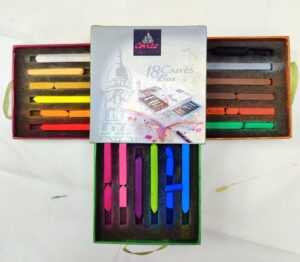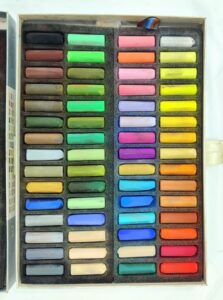Preparing and selecting your surface for pastels
You can buy paper that is specifically designed for pastels, which if you are a beginner, is a perfect way to start. This type of paper has a textured surface (known as the tooth) that holds the pigment well. Popular brands include Canson Mi-Teintes, Strathmore 400 Series Pastel and Fabriano Tiziano, to name a few. These papers come in different colours, and I will address why in a later blog.
You could try using Ultra-fine grit sandpaper (around 400-600 grit), which provides an excellent tooth for heavy pastel layers. This is great for detail but will wear your pastels down quickly. Another great option is watercolour paper. Cold-pressed or rough watercolour paper has enough texture for pastels.
You can also purchase specialty boards, such as Pastel Mat. This is a premium, velvety surface by Clairefontaine that holds multiple layers without the need for fixative. In the art world, fixative is a liquid, sprayed onto artwork, which prevents smudging, fading and crumbling of the drawing material, particularly in dry media like pastel (also chalk or charcoal).
Other products worth considering include Ampersand Pasteboard, which is a rigid board with a clay-coated surface, ideal for detailed work and, last but not least, Art Spectrum Colourfix, a textured, primed surface available in paper or board form, both excellent for heavy pastel applications.
If you are not keen on any of these surfaces you can make your own. Using acrylic gesso mixed with pumice or sand, you can apply this to paper, canvas or wood to give extra tooth to the surface.
Some artists use embossed wallpaper liner as a cheap alternative or acid-free mat board with a slight texture can work well for pastels.
There are several considerations to factor in when choosing a substrate. In my view, the key ones are:
Tooth/Texture – More texture equals better pigment adhesion, but too much can make blending difficult.
Rigidity – Heavy pastel layers may warp thin paper, so boards or thick paper are preferable.
Fixative needs – Some surfaces hold pastel better, reducing the need for fixatives.
So, finally, what should you avoid?
Firstly, smooth papers. Pastels won’t stick well to smooth surfaces like photocopy paper. In addition, photocopy paper is too thin and will warp easily. Oily or waxy surfaces won’t work either because the chalk will simply slide off the paper.
My advice when you are just starting use a pastel paper or Canson Mi-Teintes, which is forgiving and affordable. As you advance, experiment with sanded surfaces or DIY options!
NB, I do not get paid to endorse any people or brands mentioned in my blogs.
If you enjoyed this post, please like, share and follow me. Sharing, liking and following raises the algorithms in my favour.
Thank you for your support.

1 Comment.
Thank you, some great tips here that I hadn’t thought of! 😉